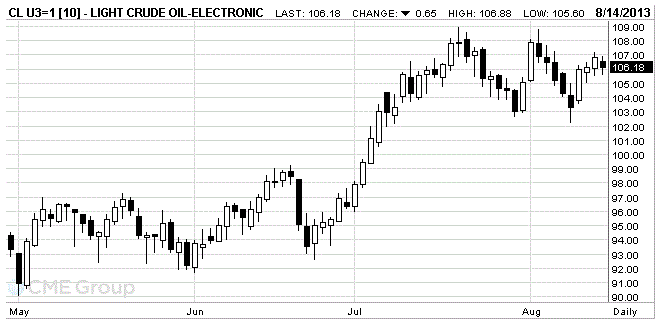- Oil: an overview of the market situation
Notícias do Mercado
Oil: an overview of the market situation
Oil prices fell today, dropping below $ 110 per barrel, due to investors' concerns regarding the fact that the U.S. Federal Reserve may soon cut back on the amount of its asset-purchase program. However, the tense situation in the Middle East, helping to hold down prices, not allowing them to fall even further. Note that the opposition in Egypt turned into a bloody phase: according to information circulating in the network, the demonstrators in clashes with the police and security forces have been killed or injured hundreds of people. The political problems in Egypt have become growth driver of the risk premium in the price of oil, and yet, after the "revolution" of the past year, there comes a relatively quiet period. However, the escalation of the crisis in Egypt could lead to the spread of problems in the neighboring territories. Against this background, the president of Egypt declared a state of emergency throughout the country.
Meanwhile, add the oil prices have ignored a report that the longest recession in the euro zone has finally ended. Preliminary data released by Eurostat, showed that the euro zone's economy emerged from recession in the second quarter of 2013. Gross domestic product grew by 0.3 percent quarter on-quarter in the second quarter, after a contraction of 0.3 percent in the first quarter. Economists had forecast a GDP growth of 0.2 percent. Quarterly GDP growth in the euro area was the fastest since the 1st quarter of 2011 compared to the same quarter of 2012, seasonally adjusted GDP declined by 0.7 percent. It was a little weaker than expected 0.8 percent drop. Eurozone recession persisted for six quarters. Earlier today, Germany and France reported on the stronger-than-expected growth in the second quarter.
We also note that the dynamics of the trade also influenced report on oil. According to the U.S. Department of Energy last week crude oil inventories decreased by 2.812 million barrels to 360.49 million barrels, gasoline inventories fell by 1.169 million barrels to 222.42 million barrels, distillate stocks rose by 2.027 million barrels to 128.482 million barrels. In addition, it was reported that refinery capacity utilization was 89.4% versus 90.9% a week earlier, and the oil terminal at Cushing fell 1.359 million barrels to 38.515 million barrels.
The cost of the September futures on U.S. light crude oil WTI (Light Sweet Crude Oil) fell to 106.18 dollars a barrel on the New York Mercantile Exchange.
September futures price for North Sea Brent crude oil mixture fell to $ 109.40 a barrel on the London exchange ICE Futures Europe.
